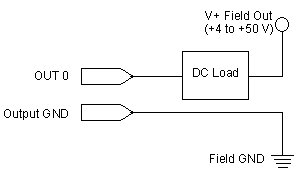


 |
 |
 |
Table of ContentsPlugging in the Power I/O Wildcard Setting Outputs and Reading Inputs Connecting High-Current Loads to the Outputs Maximum Ratings: Current, Power and Switching Frequency |
Power I/O Wildcard User GuideConnecting High-Current Loads to the OutputsThe high current MOSFET outputs are opto-isolated to 2500 volts and capable of sinking 2 amps per channel continuously using field voltages up to 50 VDC at ambient temperatures to 70?C. The outputs are protected by snub diodes connected to the field supply to prevent damage from high-voltage inductive spikes. The MOSFET outputs control DC loads only. To control AC loads, use the AC Relay Wildcard, also available from Mosaic Industries. Figure 1-1 shows how to connect a DC load (motor, solenoid, etc.) to the high current outputs. The field voltage supply, V+FieldOUT, can be as great as 50 VDC, and it must be at least 4 V to provide gate bias for the output MOSFETs. If you test the MOSFET outputs, remember to connect a load to the output in order to see a voltage change as the output changes state. To perform simple non-isolated testing to verify the functionality of the board, connect a resistor (say, 1 kΩ) between the output and any convenient field supply (such as +5V) and connect the output’s field ground to the Ground connection of the +5V supply. Then, when an output bit is off, no current will flow in the load resistor, and a voltmeter or scope will show that its voltage is high (at +5V if you used this as the field supply). If you use the software from the software section of this document to turn an output bit on, current will flow through the output resistor, and your voltmeter or scope will show that the corresponding voltage falls to near zero. The field connector on the Power I/O Wildcard is rated for continuous currents up to 2 amps and it should mate with a connector that is capable of carrying the required load current for your application. Note that standard insulation-displacement ribbon cable connectors are rated at only 1 amp per contact.  Figure 1-1. Connecting a DC load to a high current output |
Home|Site Map|Products|Manuals|Resources|Order|About Us
Copyright (c) 2006 Mosaic Industries, Inc.
Your source for single board computers, embedded controllers, and operator interfaces for instruments and automation